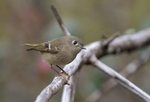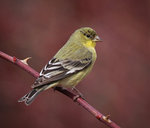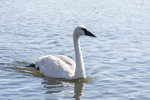




In January participants on the annual Audubon Christmas Bird Count (CBC) anticipate receiving the results of local counts. It gives us a snapshot of what birds are available for watching in the area and the relative abundance of different species, year to year.
As I have written earlier, the Olympia CBC has occurred most years since the 1940’s. The count covers a 15-mile diameter circle stretching from the Nisqually Delta on the east to Eld Inlet on the west, and north to Johnson Point. In other words, most of northern Thurston County.
This year’s count occurred on Sunday, December 18th. It was a cool day, temperatures in the 30’s, and light rain but little wind. I would have said it was a good day for a bird count, but the birds did not agree. For me, and for most of the other 107 participants, birds were quiet and inactive, especially the insectivorous small birds like the Ruby-crowned Kinglet.
The total count for all species was 39,411 birds of 122 species. Both of these totals are below average, as the usual species number for our count has typically been 126-127. The count rules allow for the reporting of species seen during the three days before or after the count day (the Count Week). This year we added eight species for the count week, making a total species count of 130. That is a good number, although a bit short of the high count of 134 species from back in the 1990’s, and suggests weather might have limited count success.
The count numbers for some individual species are interesting. Scrub Jays numbers continue to grow (this year 142) and the number of Anna’s Hummingbirds remains steady (137). Other interesting species counts are Great Blue Heron at 79 and Bald Eagle at 137.
The most common birds in our area in winter are various species of waterfowl (ducks and geese), with the single most common species being American Wigeon (3829). A nice surprise for this year was 27 Whistling Swans on Capital Lake – perhaps you have noticed these majestic birds there in recent weeks. I imagine you can guess the most common songbird – there were 1926 American Robins counted. Crows and starling counts were high as well.
In recent years we have had a new species move into our area, the Lesser Goldfinch. This species may be joining Eurasian Collared-Dove, Anna’s Hummingbird and Scrub Jay as species going from unknown to regular on the Olympia CBC.
Perhaps the most interesting of the CBC activities are the two boats that venture out into marine waters to count the birds that are otherwise seldom seen. There are two boats, one traveling Budd Inlet and Eld Inlet and the other in Henderson Inlet and the Nisqually Reach. The latter covers some deep water and occasionally encounters rare species. Our photographer Liam was on that boat this year.
The two boats generally contribute 10-12 species not seen elsewhere on the count. A good example is the Common Loon, seldom seen from land. Two other marine species are grebes, Red-necked Grebe and Western Grebe. Western Grebes are fairly large birds, black above and white below, with a long neck and pointed bill. They are aggressive fish eaters, spending their winters in Puget Sound before moving to interior lakes for summer breeding. Twenty or more years ago we would count 1000 or more Western Grebes during the CBC, but that number has declined over the years and now we seldom see more than 100. Is there a problem?
In northern Puget Sound, Western Grebe numbers remain high, with thousands frequenting northern bays and inlets. This illustrates how CBC numbers must be evaluated in the larger context. Our Western Grebe numbers are greatly reduced, but over the entire region they remain high. My conclusion is that the food supply of herring and other feeder fish is in decline around here and has been for a number of years. This is not good for grebes or salmon.
The annual Christmas Bird Count is an official function of the National Audubon Society and the numbers for Olympia and for all the counts in the nation are posted on the society’s website. Check it out – it’s a great way to learn what bird species winter back east where you used to live or down south where the relatives winter each year.
George Walter is environmental program manager at the Nisqually Indian Tribe’s natural resources department; he also has a 40+ year interest in bird watching. He may be reached at george@theJOLTnews.com
Photos for this column are provided by Liam Hutcheson, a 15-year-old Olympia area birder and avid photographer.
Comments
No comments on this item Please log in to comment by clicking here